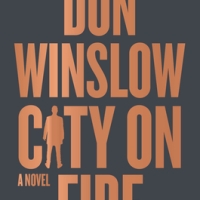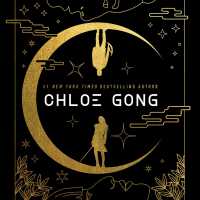Guest Post: “Licence to Chill – James Bond and Horror” by Nick Setchfield
The BiblioSanctum is pleased to be a stop on the blog tour for The War in the Dark by debut novelist Nick Setchfield, a genre-bending thriller with historical and speculative fiction elements set in Cold War Europe. Today we are excited to welcome the author as he shares with us a guest post about some of the places he gets his inspiration…and fans of a certain fictional British Secret Service agent are sure to enjoy his post! Released on July 17th from Titan Books, The War in the Dark is now available in bookstores everywhere. We hope you check it out, and be sure to also stop by the other blogs on the tour!
![]()
LICENCE TO CHILL – JAMES BOND AND HORROR
by Nick Setchfield
 Sometimes we take inspiration from the spaces inbetween.
Sometimes we take inspiration from the spaces inbetween.
I’ve always been intrigued by the shadow realm where James Bond ends and the horror genre begins. It’s the intersection I wanted to explore in my first novel, The War in the Dark, a book with a mission to splice spy fiction with the occult. Like all shadow realms its borders are in flux, so any maps we make inevitably shift and twist like a spill of mercury. No reconnaissance mission can ever hope to nail down the exact edges of this treacherous territory, so leave your compass behind as we step into the deeper darkness, on Her Majesty’s most secret service…
First, some context, because in the beginning the context was crucial. My earliest memories of Ian Fleming’s Bond stories were the Pan paperbacks stacked on the tall shelves of my local Forbuoys newsagent. I knew that they were books for grown-ups, which made them all the more enticing as I stared at their covers. And what alluringly cryptic covers they were, photographic still-life compositions with a decidedly macabre edge: You Only Live Twice places a glistening, beetle-black lobster next to an unsheathed samurai knife; Dr No juxtaposes a gun with three white sticks for the blind, their handles curling like skeletal fingers; Thunderball shows a shattered underwater breathing mask, the splintered glass almost like a ruined clockface. Looking at these images now they strike me as borderline ritualistic, like ceremonial items gathered for a dark purpose.
And the company they kept in Forbuoys certainly suggested there was something stranger waiting within those pages. British horror writer Dennis Wheatley was enjoying a renaissance around this time, his vintage tales of Satanism repackaged with lurid covers for the thrill-hungry ‘70s paperback market. So the Bond novels shared the shelves with such black magic chillers as The Devil Rides Out and The Haunting of Toby Jugg and all their delicious iconography of flaming skulls and pentagrams and sacrificial daggers. There was a weird, unspoken kinship between these books. Those shelves, I’m sure, ultimately took me to The War in the Dark.
Fleming always danced with the macabre. Like his friend Roald Dahl he had the blackest of imaginations and there’s a flavour in his work that I like to describe as a scorpion-on-a-tombstone shudder (maybe that was another cover I saw, long ago…). And that sense of gilt-edged darkness nudges 007 tantalisingly close to Wheatley’s world. Fleming’s lexicon frequently borrows from the uncanny: the criminal organisation that Bond fights is called SPECTRE, after all (noun: a ghost; a phantom; an apparition). It’s a word he was particularly partial to. From Russia With Love concerns a Soviet decoding machine called the Spektor. Diamonds Are Forever takes us to a Western ghost town named Spectreville. Elsewhere the killer in The Spy Who Loved Me, whose steel-capped teeth inspired the vampiric Jaws in the movie version, is named, simply, Horror.
Bond’s underwater exploration in Thunderball is one of Fleming’s finest pieces of writing, and there’s a wonderful touch of Lovecraft to it. We enter the fuselage of a sunken plane, buried beneath the waves of the Bahamas. It holds the decomposing corpse of a crewman and, as we discover alongside Bond, it’s infested with octopuses – “dreadful, glinting, red-eyed comets that slapped themselves into dark corners and stealthily squeezed themselves into cracks and under seats.” The creatures, we’re told, with skin-crawling understatement, have “a soft movement”. It’s the kind of prose that makes you wish he’d tapped out a full-tilt horror novel on that gold-plated typewriter of his.
Two of the Bond books come tantalisingly close. Live and Let Die is the obvious one. Fleming’s second novel, it’s considerably pulpier than its predecessor, Casino Royale. In its pages Bond encounters the priestess Solitaire, who was initiated into the ways of voodoo during her childhood in Haiti. Intriguingly, she’s presented to us as legitimately psychic, her powers exploited by the novel’s villain, Mr Big. Voodoo lore permeates this mission, making it one of the more evocative Bond adventures, heavy with drums and sweat and superstition. Solitaire identifies “an ouanga, a Voodoo fetish. It’s the invocation to the Drum Witch. It’s used by the Ashanti tribe in Africa when they want to kill someone.” Elsewhere we hear of a cursed island that’s now regarded as “ju-ju”. Mr Big himself is believed to be a manifestation of Baron Samedi, the spirit of darkness and death, or at least one of his zombie servants. The movie version amps up the horror angle, making the Baron a separate character, a cackling trickster figure who’s strongly suggested to be an authentic supernatural force…
Published in 1964, less than five months before its author died, You Only Live Twice may just be Fleming’s strangest, most genuinely haunting tale. In places it reads less like an espionage story and more like a fever dream, rich with symbolism and allegory. Bond is on the trail of his nemesis, Blofeld, who has retreated to Japan to curate a Garden of Death. Seeded with poisonous plants and stocked with flesh-eating fish and lethal reptiles, it’s a literal death trap, a magnet for a suicide cult that’s sweeping the country. The Garden is an extraordinary idea, one of Fleming’s most resonant. It feels torn from fairytale or folklore, somewhere deeper and weirder than 007’s usual jet-set playground.
It’s here, in this phantasmagorical “killing bottle” of a location, that Bond faces mortality, just ahead of his creator: You only live twice, claims the quote that opens the book, once when you are born, and once when you look death in the face. It’s a liminal space between this world and the other, and as Fleming’s hero walks this landscape he edges closer than ever to the unknown, to a world of dream and nightmare.
Welcome to the shadow realm, Mr Bond. We’ve been expecting you.
![]()
Nick Setchfield is a writer and features editor for SFX, Britain’s best-selling magazine of genre entertainment in film, TV and books. A regular contributing writer to Total Film, he’s also been a movie reviewer for the BBC and a scriptwriter for ITV’s Spitting Image. The War in the Dark is his first novel. He lives in Bath.














After reading this guest post, I’m adding The War in the Dark to my TBR. Ive never heard of him, but Setchfield is a damn good writer!
LikeLike
He really is, and apparently he’s also been writing for a while, for a sci-fi magazine!
LikeLike
it looks intriguing there and it’s the first time I hear about it!
LikeLike
Yep, really cool guest post, and I’m grateful to Mr. Setchfield for sharing with us!
LikeLike
How fascinating! I never considered the horror angle in the Bond stories, but it all makes a great deal of sense… and I simply *love* the “license to chill” callback! 🙂
Another title for my “wanted” list, and thanks for sharing!
LikeLike
I’d never considered it either, but looking back at some of the older Bond films, I can totally see it now!
LikeLike
Well that was different and something new 😀
LikeLike
Haha, yeah, this was a brilliant post!
LikeLike
Cool blend. Looking forward to reading it.
LikeLike
Me too. I’ve already seen some good reviews, I can’t wait to dive in.
LikeLiked by 1 person
This sounds wild. James Bond meets the occult/horror? Worth adding to the TBR!
LikeLike
I know, right? That description sold me.
LikeLike
Great post – I’m thoroughly intrigued – gonna have to read this one. Thanks for giving this one a spotlight. Cheers, Brian
LikeLike
I’m very eager to dive into my copy too, after this post.
LikeLiked by 1 person
My copy got here on Friday. May give it a look tonight. Cheers, Brian
LikeLike
I actually discovered this book yesterday, accidentally! I’m really surprised by how little media publicity it got cause this book really sounds awesome! The author’s inspirations just makes his book even more alluring! Thanks for sharing! 😀
LikeLike
For real, right? I’ve only seen a few reviews. Setchfield writes for a pretty big sci-fi magazine in Britain, so I was surprised it’s not gotten more publicity.
LikeLiked by 1 person
Is it at all like Charles Stross’s Lovecraftian take on the James Bond franchise? Those have become very dark.. I love the sound of this one, though – thank you for a really great article!
LikeLike
I’m not sure, because I haven’t been aware of what Stross has been writing lately, but wow, Lovecraft and Bond? Now you’ve gotten me intrigued 🙂
LikeLiked by 1 person
It’s a fantastic series – I’ve loved it. Very quirky with lots of Brit humour, though getting steadily darker, as well. I really love his writing and this series has been fabulous.
LikeLike
I saw really positive comments by Bob over on twitter so this book had hit my radar – and now it’s blown my radar out of the water. Onto the list it goes then.
Lynn 😀
LikeLike
Yeah, I saw his review recently. Dang it sounds good!
LikeLike
Pingback: Mogsy’s Bookshelf Roundup: Stacking the Shelves & Recent Reads | The BiblioSanctum
Pingback: Mogsy’s Bookshelf Roundup: Stacking the Shelves & Recent Reads | The BiblioSanctum